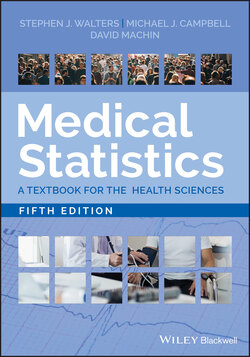Читать книгу Medical Statistics - David Machin - Страница 89
Example – Summarising Results from a Clinical Trial– Corn Plasters: Odds Ratio
ОглавлениеFrom Table 3.4, the odds of the corn resolving by three‐months in the plaster group is 0.337/(1 − 0.337) = 0.508; whilst the odds of resolution in the scalpel group is 0.213/(1 − 0.213) = 0.270. Thus, the odds ratio for the corn resolving by three months in the plaster compared to the scalpel treated group is 0.508/0.270 = 1.88. You can also calculate the odds ratio by using the four cell counts in the 2 × 2 contingency table of Table 3.3. The odds ratio for the corn resolving in the plaster group compared to the scalpel group is OR = (32 × 74)/(20 × 63) = 1.88.
The OR = 1.88 and RR = 1.58 with these trial data are clearly different. However, when the probability of an event happening is rare, the odds and probabilities are close, because when a is much smaller than c then the risk a/(a + c) is approximately a/c. Further if b is much smaller than d then b/(b + d) is approximately b/d, then RR = (a/c)/(b/d). Thus, the OR approximates the RR when the successes are rare, say with a maximum incidence less than 10% of either pTest or pControl Sometimes the odds ratio is referred to as ‘the approximate relative risk’. The approximation is demonstrated in Table 3.6.
Table 3.6 Comparison of RR and OR for different baseline rates.
| p Test | p Control | RR | OR | RR and OR |
|---|---|---|---|---|
| 0.05 | 0.1 | 0.5 | 0.47 | Close |
| 0.1 | 0.2 | 0.5 | 0.44 | Close |
| 0.2 | 0.4 | 0.5 | 0.38 | Not close |
| 0.4 | 0.2 | 2 | 2.66 | Not close |
| 0.2 | 0.1 | 2 | 2.25 | Close |
| 0.1 | 0.05 | 2 | 2.11 | Close |
